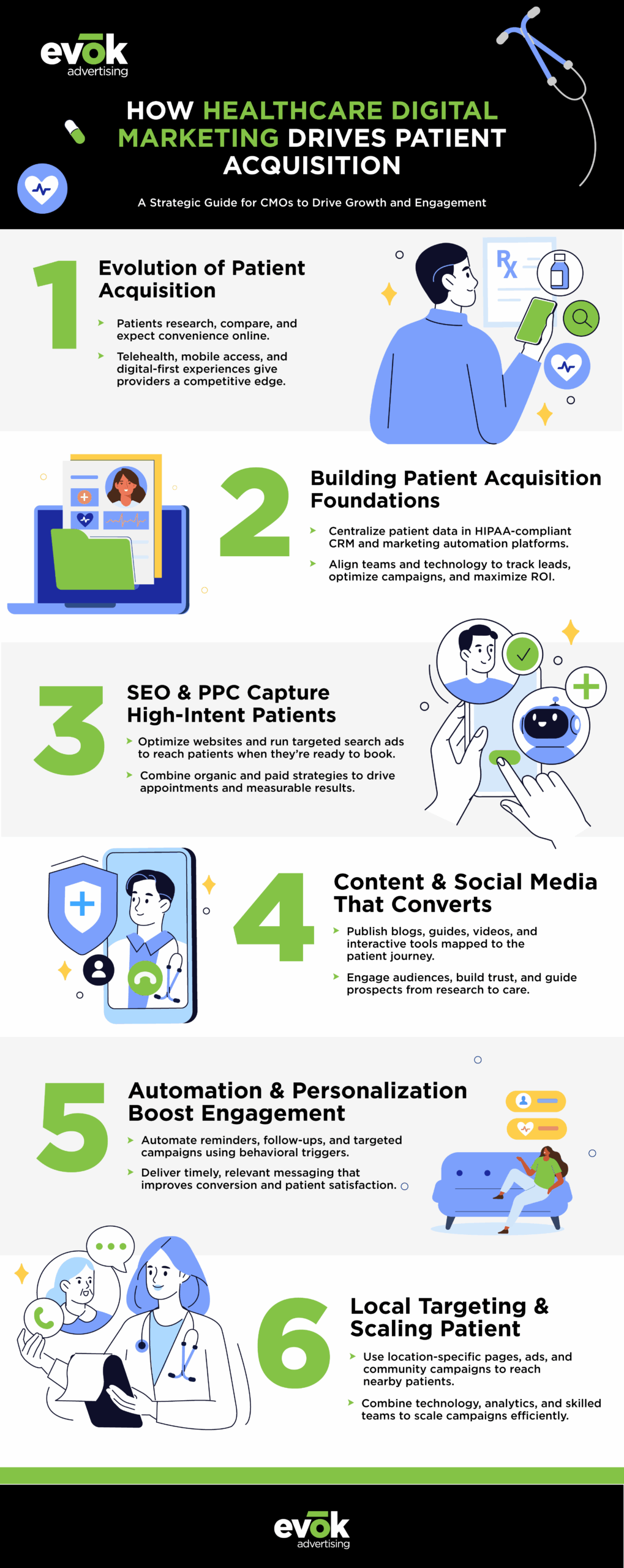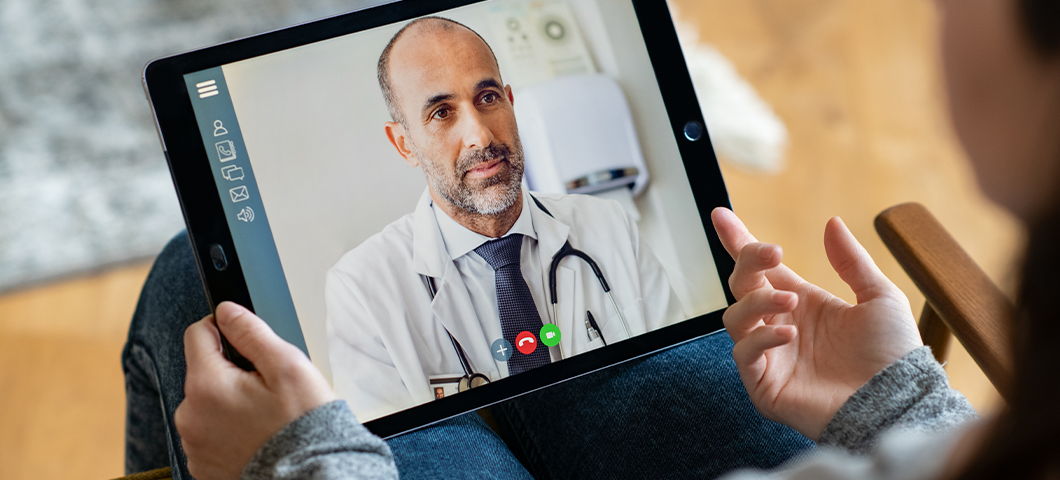
Healthcare Patient Acquisition: Digital Marketing Strategies That Drive Growth
Why Patient Acquisition Requires Digital-First Thinking
Healthcare patient acquisition has reached a critical inflection point in 2025. While many healthcare organizations accelerated digital transformation during the pandemic, simply maintaining an online presence is no longer enough to drive sustainable patient growth. Traditional marketing strategies, such as relying on referrals, broad awareness campaigns, and generic advertising, are failing to deliver the volume and quality of patients that healthcare organizations need to thrive.
Patients now behave more like consumers in other industries. They research providers online, compare options, read reviews, and expect personalized, convenient experiences at every touchpoint. This shift means that the patient journey is more complex and multi-dimensional than ever before.

For CMOs, this evolution requires a complete rethinking of patient acquisition marketing strategies, moving beyond simple outreach to robust healthcare patient recruitment strategies that engage and retain individuals throughout their care journey. Marketing teams must adopt advanced analytics, multi-channel attribution, and automation to identify, engage, and convert high-value patients. Patient acquisition is no longer about casting a wide net—it requires precision, personalization, and measurable outcomes across complex, multi-touch journeys.
The opportunity is significant. By implementing integrated healthcare digital marketing strategies, spanning SEO, PPC, content marketing, social media engagement, and marketing automation, healthcare organizations can capture high-intent patients, improve retention, and drive sustainable healthcare growth strategies. This guide provides CMOs with a strategic framework for building patient acquisition systems that are both scalable and effective, outlining key healthcare patient acquisition tactics that a forward-thinking healthcare marketing agency and its comprehensive healthcare marketing agency services can achieve for patient growth.
The Evolution of Healthcare Patient Acquisition in 2025

The way patients choose providers has fundamentally shifted. Once driven by physician referrals or location convenience, patient acquisition now depends heavily on digital visibility and consumer-first online patient acquisition strategies. Patients expect the same level of convenience from healthcare that they experience in retail or hospitality, making transparency and accessibility critical to acquisition success.
One of the most significant changes is the rise of telehealth and hybrid care models. The CDC reports that telehealth visits increased by 154% in March 2020 compared to the same month in 2019, and digital care continues to shape patient expectations. Today, providers offering seamless scheduling, virtual consultations, and integrated follow-up care hold a competitive advantage in attracting new patients.
Generational preferences also influence acquisition. Gen Z and millennial patients rely heavily on smartphones, making mobile-optimized websites and booking tools essential for engaging these audiences. Meanwhile, older generations continue to value physician referrals and credibility markers such as board certifications. A successful acquisition strategy must balance digital convenience with traditional trust-building across demographics.
Key Factors Driving Patient Acquisition Shifts
- Consumer control: Patients compare providers like shopping for retail services.
- Telehealth adoption: Access to virtual care is a major decision factor.
- Generational divides: Younger patients demand digital convenience, while older patients seek credibility through referrals.
Digital Marketing Foundations: Building Patient Acquisition Infrastructure

A strong digital marketing foundation is essential for healthcare organizations seeking sustainable patient acquisition. Success starts with a HIPAA-compliant CRM system that captures leads, tracks patient interactions, and manages the entire lifecycle from first inquiry to follow-up. Without this infrastructure, patient acquisition digital campaigns risk being fragmented, difficult to measure, or non-compliant with privacy regulations. Integrating marketing automation platforms allows teams to deliver personalized messaging at scale, while analytics dashboards provide actionable insights to optimize campaigns and maximize ROI.
Cross-functional alignment is equally critical. Marketing teams must collaborate with clinical operations, patient experience staff, and compliance departments to ensure campaigns are both effective and regulatory-compliant. Front-line feedback informs content, messaging, and touchpoint design, enabling a smoother patient journey and higher conversion rates. Organizations that successfully integrate teams and technology see measurable improvements not only in lead volume but also in lead quality and retention.
Healthcare Marketing Tech Stack Essentials
A modern healthcare marketing technology stack integrates a CRM, marketing automation platform, analytics tools, and telehealth solutions, enabling providers to track patient behavior, segment audiences, and personalize campaigns while maintaining HIPAA compliance. Digital health technology has been shown to improve healthcare digital patient engagement when embedded in acquisition strategies. Predictive analytics and cohort analysis allow marketing teams to anticipate demand, target high-value patients, and optimize lifetime value, ensuring marketing dollars are spent efficiently.
A comprehensive data strategy complements technology by leveraging first-party data, including appointment histories, engagement metrics, and inquiries. This enables predictive modeling that identifies patient needs before they arise, allowing timely, personalized outreach. Automated workflows such as appointment reminders, follow-up emails, and referral requests improve engagement and reduce administrative burden. By combining technology, data strategy, and cross-functional alignment, healthcare organizations create scalable, measurable patient acquisition systems that drive growth.
Search Engine Optimization: Capturing High-Intent Healthcare Searches

Search engine optimization (SEO) drives some of the highest‑converting traffic in healthcare patient acquisition. According to BrightEdge, 68% of online experiences begin with a search engine, underscoring how often patients start their health journey online.
From symptom research and provider comparison to final appointment booking, SEO enables healthcare organizations to capture patient intent across multiple stages of the journey. When done well, healthcare SEO delivers measurable returns—more organic traffic, better lead quality, and lower patient acquisition costs compared to paid channels over the long run.
Healthcare SEO success is built on four interlinked pillars:
1. Technical Performance
Technical SEO ensures search engines can crawl, index, and rank your content, and that users have a good experience. Key performance metrics (Core Web Vitals) from Google include:
- Largest Contentful Paint (LCP): ≤ 2.5 seconds for good loading performance.
- Interaction to Next Paint (INP): < 200 milliseconds for responsiveness.
- Cumulative Layout Shift (CLS): < 0.1 for visual stability.
Other technical essentials include secure HTTPS hosting, structured data markup for providers, services, and locations, clear XML sitemaps, clean URL hierarchies, and mobile-first design. Because Google uses mobile-first indexing, optimizing speed and usability on mobile is particularly crucial.
2. Local Visibility (“Near Me” and Geo‑Targeting)
Healthcare is inherently local for many patients. Search terms such as “provider near me” or “clinic + city/neighborhood” often reflect strong intent to seek care imminently. To capture this:
- Maintain fully optimized Google Business Profiles (GBP), with accurate contact info, services, photos, and regular updates.
- Create location‑ or neighborhood‑specific landing pages that address local issues, provider proximity, hours, and specialty offerings.
- Build and manage citations in healthcare directories (e.g. Healthgrades, WebMD, Zocdoc) to strengthen authority locally.
- Encourage reviews and ratings (while maintaining HIPAA and privacy compliance), as these influence local ranking and patient trust.
3. Content Authority & E‑E‑A‑T (Expertise, Experience, Authoritativeness, Trustworthiness)
Search engines and users alike expect healthcare content to be credible, accurate, and trustworthy. To build content authority:
- Publish content authored or reviewed by qualified healthcare professionals, with credentials clearly stated.
- Build topic clusters (e.g. for particular conditions) covering symptoms, treatments, prevention, patient FAQs, etc. These clusters help search engines understand topical relevance and offer multiple entry points for patients.
- Include content comparing treatment options, expected outcomes, and patient concerns. While being clear, avoid giving medical advice unless by licensed providers.
- Address local health topics — regional health trends, community health events, and locale‑specific patient concerns can give unique authority.
4. Advanced Optimization Tactics: Voice Search, Featured Snippets, UX & Navigation
To stand out in competitive healthcare markets, go beyond basics:
- Create FAQ‑style content optimized for conversational or voice‑search queries (e.g. “What are signs of pneumonia?”, “Can I do virtual consultation for dermatology?”).
- Optimize for featured snippets by having clearly structured, concise answers (40‑60 words), with headers, bullet lists, and definitive responses for common questions.
- Use internal linking to guide users from educational content toward service pages or appointment booking.
- Include video or multimedia content where appropriate (e.g. procedure walk‑throughs, provider introductions) to support engagement.
- Perform competitor gap analysis to find topics or content types competitors aren’t covering well.
Timeline & Expectations
SEO is a long game. Most healthcare providers see meaningful improvements in organic traffic, appointment calls, or leads in 6‑12 months after a comprehensive SEO strategy is implemented and consistently maintained. Early gains may come from quick wins like improving site speed, content updates, and local visibility, but sustainable patient acquisition depends on ongoing optimization, content freshness, and monitoring.
Healthcare SEO Impact on Patient Acquisition
According to a BrightLocal report, 93% of consumers use online searches to find local businesses, including healthcare providers, and 79% of consumers trust online reviews as much as personal recommendations. Integrating local SEO, long-tail keywords, and voice-search optimization ensures that healthcare organizations capture high-intent traffic and guide patients toward conversion. Symptom-specific content, treatment guides, and educational resources provide authoritative value that both patients and search engines recognize.
Keyword strategy should align with patient intent across the decision-making journey, from symptom awareness to provider selection. Long-tail and conversational keywords often drive higher conversion rates because they match specific patient needs. By combining technical SEO, content optimization, and local targeting, CMOs can maximize visibility, attract high-value patients, and complement other digital marketing channels such as PPC and social media, creating a holistic acquisition ecosystem.
Pay-Per-Click Advertising: Targeted Campaigns for Patient Volume

Pay-per-click (PPC) advertising allows healthcare organizations to capture high-intent patients quickly, placing their services at the top of search results for specific treatments, conditions, or service lines. Unlike organic search, PPC provides immediate visibility and can be a powerful engine for healthcare lead generation, generating qualified patient leads within days of campaign launch. In highly competitive healthcare markets, PPC complements SEO, helping organizations secure appointments from patients actively searching for care.
Successful PPC campaigns require strategic account structure, audience segmentation, and optimized landing pages. Campaigns should be organized by service line, specialty, or patient segment to ensure ad relevance and improve Quality Scores. Geographic targeting is essential, as patients typically seek providers within convenient distances. Additionally, ad scheduling ensures visibility during peak search times, maximizing budget efficiency. Landing pages must reduce friction with clear calls-to-action, trust signals such as provider credentials and HIPAA-compliant messaging, and mobile-friendly forms to convert clicks into booked appointments.
PPC Effectiveness in Healthcare Marketing
Healthcare advertisers benchmark an average conversion rate of 3.27% on search campaigns, with click-through rates at a similar 3.27%. Performance is even stronger when campaigns focus on specific services or local markets. According to LocaliQ’s healthcare advertising benchmarks, search ads deliver some of the highest ROI opportunities in the vertical, with overall average CTRs at 5.66% and CPLs around $47.69 across subcategories.
Integrating PPC campaigns with broader digital marketing strategies enhances performance. For example, aligning ad messaging with content marketing and SEO ensures consistency across patient touchpoints. Retargeting campaigns also capture patients who have engaged with your website but have not yet booked an appointment. By leveraging behavioral targeting, location data, and conversion-optimized creative, CMOs can efficiently generate high-quality leads and drive immediate patient volume while building long-term brand credibility.
Content Marketing Strategies That Convert Healthcare Prospects Into Patients

Content marketing has become a key driver of patient acquisition by providing informative, trustworthy resources that guide patients through each stage of the healthcare decision-making process. Patients often begin with symptom-based research, move toward exploring treatment options, and ultimately evaluate providers. A robust content strategy ensures that healthcare organizations deliver value at every stage, establishing authority and building trust while nurturing prospects toward conversion.
Effective content marketing requires mapping content to the patient journey. Blogs, videos, guides, and interactive tools should address patient questions, alleviate concerns, and provide actionable insights. Expert-authored content, such as physician articles or treatment explainers, enhances credibility and improves E-A-T (expertise, authority, trustworthiness) signals in search rankings. Integrating content clusters around specific conditions or service lines not only improves SEO but also supports multi-channel campaigns, reinforcing messaging across social media, PPC, and email outreach.
Content Marketing ROI in Healthcare
In healthcare, condition-focused content and interactive tools such as symptom checkers or assessment questionnaires can capture first-party data, guide patients through personalized experiences, and improve conversion rates. By aligning content with patient intent, healthcare organizations can influence decisions, retain patients longer, and drive measurable acquisition growth.
Editorial planning and content calendars are critical for consistency. Seasonal campaigns (e.g., flu prevention, chronic condition awareness) and timely educational pieces ensure ongoing patient engagement. Incorporating interactive content like virtual consultation scheduling, health quizzes, or online assessment tools creates opportunities to capture leads and guide patients seamlessly from interest to appointment booking.
By combining educational, authoritative content with interactive and personalized tools, healthcare organizations can transform prospects into patients, support long-term retention, and complement other digital marketing initiatives to build a comprehensive, patient-centered acquisition strategy.
Social Media Patient Acquisition: Platform-Specific Engagement Tactics

Social media has become a vital channel for healthcare patient acquisition, enabling organizations to engage directly with patients, share educational content, and drive appointment bookings. Platforms such as Facebook, Instagram, LinkedIn, and YouTube allow CMOs to reach high-value patient segments, provide credible health information, and strengthen brand trust. Social media also supports community building, allowing organizations to foster ongoing relationships and encourage referrals through authentic interactions.
Effective healthcare social media strategies balance engagement with compliance. All content must adhere to HIPAA regulations and platform-specific advertising rules, ensuring patient privacy while maintaining credibility. Paid campaigns allow precise demographic and geographic targeting, reaching users who are most likely to schedule appointments. Organic content—such as educational posts, patient success stories, and health awareness initiatives—builds authority, reinforces messaging from other channels, and encourages ongoing engagement.
Social Media Influence on Healthcare Decisions
A 2023 Pew Research report found that a significant portion of adults use online platforms, including social media, to research health information, with many reporting that this content influences their healthcare decisions. Healthcare organizations can leverage these insights to create educational, trustworthy content that guides patients and integrates clear calls-to-action, encouraging appointments and inquiries.
Platform-specific tactics include:
- Facebook & Instagram: Paid ads targeting location, age, and health interests; organic content such as patient testimonials, educational posts, and live Q&A sessions.
- LinkedIn: Sharing thought leadership, professional insights, and specialized service line updates to attract referrals and industry credibility.
- YouTube: Publishing educational videos, explainer content, and procedural guides that demonstrate expertise and improve search visibility.
By integrating paid, organic, and community-focused strategies, healthcare organizations can generate high-quality leads, foster trust, and maintain a consistent presence across patient touchpoints. Analytics on engagement, click-throughs, and appointment requests further inform campaign optimization, ensuring social media efforts contribute directly to measurable patient acquisition growth.
Marketing Automation and Personalization for Healthcare Lead Nurturing

Healthcare lead generation is significantly enhanced by marketing automation and personalization, enabling organizations to deliver timely, relevant communication across multiple touchpoints. Patients expect tailored messaging from initial inquiry to post-treatment follow-up, and automation allows healthcare marketing teams to meet these expectations at scale while reducing manual workload. By integrating automated workflows with personalization strategies, CMOs can nurture leads, increase engagement, and convert prospects into booked appointments more efficiently.
Automation workflows in healthcare often include appointment reminders, follow-up sequences after consultations, post-treatment care instructions, and referral request campaigns. Behavioral triggers enhance personalization by reacting to patient actions in real time—for example, sending reminders to patients who abandon an online appointment form. These workflows integrate with CRM systems to track interactions and capture actionable insights, improving both acquisition and retention metrics.
Automation Improves Healthcare Engagement
Personalization extends well beyond simply addressing patients by name. It encompasses dynamic email campaigns, targeted retargeting ads, and customized landing pages that align with patients’ interests, past interactions, and preferred communication channels. For instance, patients who previously booked telehealth appointments might receive messaging highlighting virtual care options, while new patients are introduced to in-office services and provider expertise.
By combining marketing automation with personalization, healthcare organizations can maintain consistent engagement, improve conversion rates, and scale patient acquisition without overburdening clinical or administrative staff. When integrated with broader marketing initiatives such as SEO, PPC, and content marketing, these strategies not only maximize ROI but also foster stronger, long-term relationships with patients throughout the care journey.
Multi-Channel Attribution: Measuring Patient Acquisition ROI Across Touchpoints

Multi-channel attribution is essential for healthcare organizations to understand which marketing channels drive patient acquisition and optimize ROI. Patients often interact with multiple touchpoints—search engines, social media, email campaigns, and offline referrals—before booking an appointment. Without accurate attribution, CMOs risk overinvesting in underperforming channels while missing opportunities to optimize high-performing campaigns. Integrating data from web analytics, call tracking, CRM systems, and marketing automation platforms creates a comprehensive view of the patient journey and enables data-driven decision-making.
Effective attribution models help organizations measure impact at every stage. First-touch attribution identifies which channels introduce patients to the organization, while last-touch attribution shows the final conversion point. Multi-touch attribution, however, provides the most accurate insight by assigning value across all interactions, ensuring marketing investments reflect the full patient journey. Incorporating offline conversions, such as phone calls or in-person visits, is especially critical in healthcare, where many patients still schedule appointments outside digital channels.
Importance of Multi-Channel Attribution
Companies that implement multi-channel attribution are more likely to improve marketing ROI because they can identify the highest-performing channels and allocate resources effectively. In healthcare, this approach allows CMOs to measure which campaigns generate the most qualified leads, track conversion paths, and optimize messaging across digital and offline touchpoints.
Attribution insights also support predictive analytics, enabling organizations to forecast acquisition outcomes and assess patient lifetime value. By understanding which channels contribute most to patient engagement and retention, healthcare marketing teams can prioritize budget allocation, refine targeting strategies, and deliver consistent, patient-centric messaging across all touchpoints. Proper multi-channel attribution ensures marketing efforts are both efficient and measurable, providing a competitive advantage in increasingly complex healthcare markets.
Local Market Penetration: Geographic Targeting for Healthcare Organizations

Local market penetration is critical for healthcare organizations seeking to attract patients within specific service areas. Even the most sophisticated digital campaigns can underperform if they fail to account for geographic relevance. In 2025, patients will increasingly search for providers “near me” or within convenient distances, making hyperlocal targeting a key component of patient acquisition strategies. CMOs must ensure campaigns reflect regional preferences, demographic trends, and competitive landscapes to drive measurable results.
Effective geographic targeting includes location-specific landing pages, geo-targeted advertising, and community engagement initiatives. Landing pages tailored to each location improve search visibility, highlight local services, and provide convenient access to appointment scheduling. Geo-targeted ads allow organizations to focus ad spend on high-potential areas while minimizing waste in low-performing regions. Community initiatives, such as local health events or sponsorships, reinforce brand awareness and establish trust with prospective patients in the area.
Local Targeting Improves Patient Acquisition
By focusing on local search intent and producing location-specific content, healthcare organizations can drive more appointments, boost patient engagement, and establish stronger authority within their communities.
Hyperlocal campaigns also support data-driven decision-making. By evaluating performance metrics by location, marketing teams can allocate budgets to the areas delivering the highest returns, maximizing efficiency and impact. When geographic targeting is combined with SEO, PPC, and content marketing, it creates a cohesive strategy that attracts patients while fostering long-term trust and credibility in each market. CMOs who prioritize hyperlocal patient acquisition gain a competitive advantage by delivering relevant, timely, and convenient experiences that align with patient needs and expectations.
Scaling Patient Acquisition: Technology Stack and Team Structure for Growth

Scaling patient acquisition in healthcare requires more than increasing marketing budgets; it demands a robust technology ecosystem, optimized processes, and a skilled marketing team. In 2025, healthcare organizations must integrate CRM systems, marketing automation platforms, analytics tools, and content management systems to effectively manage complex patient journeys. A cohesive technology stack ensures campaigns across SEO, PPC, social media, and content marketing are measurable, trackable, and optimized for ROI.
A critical challenge is structuring teams that can leverage these technologies while maintaining compliance and strategic alignment. Hybrid models combining in-house experts and specialized agency support allow organizations to scale campaigns without sacrificing quality or regulatory oversight. Key roles include marketing analysts, content strategists, paid media specialists, and CRM administrators, all collaborating to execute high-performing acquisition strategies.
Technology and Team Alignment Boosts Acquisition
Budget allocation and resource planning are also essential. Channels should be prioritized based on performance data, with dynamic reallocation to maximize patient acquisition and minimize wasted spend. Emerging technologies, such as AI-driven predictive analytics, machine learning for personalization, and multi-touch attribution, allow healthcare organizations to future-proof marketing strategies and scale efficiently while maintaining high-quality patient experiences.
By aligning the right technology with skilled teams and strategic workflows, CMOs can build scalable patient acquisition systems that drive sustainable growth. This approach ensures marketing investments translate into measurable outcomes, including increased appointments, improved retention, and enhanced patient lifetime value, positioning organizations for long-term success in a competitive healthcare market.
Driving Sustainable Growth Through Strategic Patient Acquisition

Healthcare patient acquisition in 2025 is increasingly digital, data-driven, and patient-centric. Modern patients behave like consumers, expecting personalized experiences, rapid responses, and convenient access to care. For CMOs, success requires a holistic approach that integrates SEO, PPC, content marketing, social media, marketing automation, attribution modeling, and geographic targeting into a cohesive patient acquisition strategy. This integrated approach defines modern patient acquisition marketing and is essential for sustained growth.
Building this ecosystem demands a strong technology stack, cross-functional team alignment, and robust analytics capabilities. By implementing these strategies, healthcare organizations can convert high-intent searches into appointments, engage patients through multiple touchpoints, and accurately measure ROI across channels.
The CMOs who succeed are those who blend advanced digital strategies with patient-centered experiences, continuously optimize campaigns, and scale efficiently. Ready to expand your patient base and dominate your market? Ready to expand your patient base and dominate your market? Contact us today and discover how our team delivers measurable healthcare marketing strategies that drive real patient acquisition results.